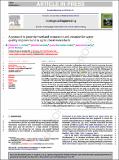Por favor, use este identificador para citar o enlazar a este item:
http://hdl.handle.net/10261/77887COMPARTIR / EXPORTAR:
 SHARE SHARE
 CORE
BASE CORE
BASE
|
|
| Visualizar otros formatos: MARC | Dublin Core | RDF | ORE | MODS | METS | DIDL | DATACITE | |

| Título: | A protocol to prioritize wetland restoration and creation for water quality improvement in agricultural watersheds |
Autor: | Comín, Francisco A. CSIC ORCID ; Sorando, Ricardo CSIC ORCID ; Darwiche-Criado, Nadia CSIC; García García, Mercedes CSIC; Masip, Adriá | Palabras clave: | Wetlands Protocol Water quality Nitrate Semi-arid Agriculture Watershed |
Fecha de publicación: | 30-may-2013 | Editor: | Elsevier | Citación: | Ecological Engineering (on-line first):2013 | Resumen: | [EN] With adequate planning, wetland restoration and creation can be useful tools for improving the water quality of natural ecosystems in agricultural territories. Here, a protocol for selecting wetland-restoration sites at the watershed scale is proposed as part of a demonstration project (EU Life CREAMAgua) for improving wastewater from irrigated agricultural land discharging into the Flumen River (Ebro River Valley, NE Spain). This watershed is semiarid, and 70% of its 1430-km2 area is used for irrigated agriculture. A preliminary study of the physical and chemical characteristics of the Flumen River and its watershed identified nitrates as the key water-quality characteristic in terms of data variability. The protocol consisted of five steps that encompassed scientific–technical, social and economic criteria. The first step was to select all of the sites in the watershed that had the hydrogeomorphic characteristics of a wetland. The second step was to estimate the levels of nitrate discharge through all of the tributaries discharging to the river and to select the sub-watersheds that contributed the most nitrates. The program SWAT (Soil and Water Assessment Tool), which considers the biophysical characteristics and land uses of the watershed, including farming practices, was utilized in these first two steps. In the third step, a first-order area-removal model was used to rank wetlands for nitrate removal. The wetland sites that were estimated to be most efficient for nitrate removal were selected. These wetland sites were located in the agricultural zone within the watershed, where fertilizers and irrigation are intensively used. In the next step, the previously selected sites were considered based on a social-availability criterion (the potential to obtain at no cost the land required to restore or create wetlands at those sites). Finally, the concordance between site availability and funding was used to sequentially select 15 sites (135 ha) that would be cost-effective for the Flumen River watershed project, which provided a case study. This protocol is compared to previously published protocols with the same purpose, and the applications of this procedure are discussed in terms of up-scaling and integrating experience in land-use and agricultural policies. | Descripción: | 9 páginas, 7 figuras. | Versión del editor: | http://dx.doi.org/10.1016/j.ecoleng.2013.04.059 | URI: | http://hdl.handle.net/10261/77887 | DOI: | 10.1016/j.ecoleng.2013.04.059 | ISSN: | 0925-8574 |
| Aparece en las colecciones: | (IPE) Artículos |
Ficheros en este ítem:
| Fichero | Descripción | Tamaño | Formato | |
|---|---|---|---|---|
| Comin_protocol to prioritize wetland restoration2013.pdf | 1,63 MB | Adobe PDF |  Visualizar/Abrir |
CORE Recommender
SCOPUSTM
Citations
32
checked on 08-abr-2024
WEB OF SCIENCETM
Citations
28
checked on 26-feb-2024
Page view(s)
424
checked on 17-abr-2024
Download(s)
537
checked on 17-abr-2024
Google ScholarTM
Check
Altmetric
Altmetric
NOTA: Los ítems de Digital.CSIC están protegidos por copyright, con todos los derechos reservados, a menos que se indique lo contrario.
